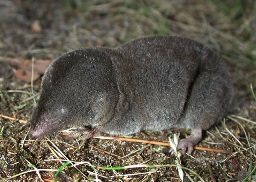Shrews are small mammals, generally smaller than the average mouse, ranging in length from 3 to 4 inches. They have pointed snouts, very small eyes, and are covered with short dense velvet fur. The teeth are small, sharp, and dark purple pigmented. Shrews are similar to mice except that mice have four toes on their front feet, larger eyes, bicolored fur, and a short snout, rather than an elongated snout. Moles also are similar to shrews, but usually are larger and have enlarged front feet for digging. Both shrews and moles are insectivores; mice are rodents.
Several species of shrews can be found across Nebraska. Specific identification of shrews may be difficult. They exist in practically all terrestrial habitats, but seem to be most common close to forested areas in the eastern portion of the state.
Shrews are insectivores, yet opportunistic feeders, meaning they will eat whatever they can take advantage of. Food habit studies reveal that shrews eat beetles, grasshoppers, and crickets, spiders, snails, earthworms, slugs, centipedes, and millipedes. Shrews also eat small birds, mice, small snakes, and even other shrews when the opportunity presents itself. Some species of shrews will eat seeds, roots, and other vegetable matter.
Shrews are mostly nocturnal. They frequently use tunnels made by voles and moles. During periods of occasional abundance, shrews may have a strong, although temporary, negative impact on mouse or insect populations. If only we could tame shrews to eliminate mice that enter our homes - but as any good Shakespearian knows, there is no "Taming of the Shrew." Many predators kill shrews, but few actually eat them. Owls, in particular, consume large numbers of shrews.
Most shrews do not cause significant negative impacts and are not usually abundant enough to be considered pests. They may actually eat mice and voles that are causing landscape damage. Shrews rarely conflict with people; however, some may consume grain products.

